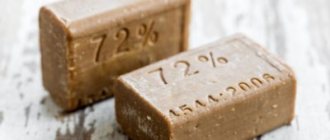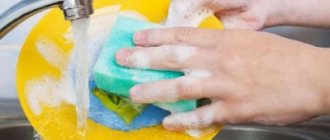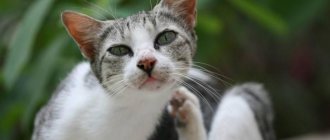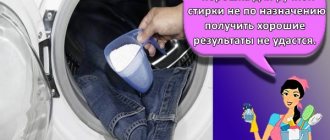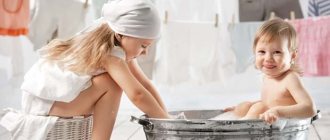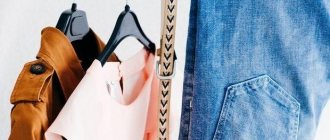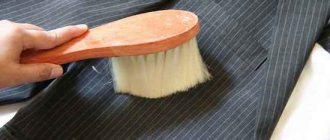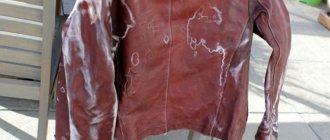08 October 2016
Averyanova Sveta
With the birth of a baby in the family, new and unusual troubles await mom and dad. One of the main ones is how and with what to wash a newborn’s clothes. Some parents don’t even realize how sensitive their baby’s skin is, and the residue of detergents on children’s clothes can trigger allergies.
Some mothers realize this when the child is already suffering from itching or redness. Therefore, it is important to learn everything about washing your child’s clothes before the baby is born.
Over the past few years, doing laundry has become much easier than before, when you had to rub soap and wash children's clothes by hand. But even at the present time, it is necessary to treat this matter in a special way.
Should I wash new clothes for my baby?
Newborn babies are very vulnerable to external factors, microorganisms and bacteria. Your task is to protect the baby as much as possible from such influences.
Pay utmost attention to new things that, although not visibly dirty, may still contain particles of dust and bacteria. You cannot be sure that diapers, rompers and baby vests were stored in proper conditions and were not soiled during sale. In addition, to make them look presentable, some manufacturers sprinkle their products with starch, which can cause skin irritation.
Detergents for washing children's clothes
In the assortment of household laundry chemicals you will find a wide variety of substances designed to remove dirt from children's clothing.
Baby soap
Baby soap differs from regular soap primarily in its composition. If a classic bar contains additional synthetic components and fragrances, then children's soap does not contain them. The composition includes only salts of animal fats, glycerin and water.
By using baby soap to wash your baby's clothes, you will not only easily remove dirt, but also protect your child from contact with dangerous chemicals that can cause irritation and dry skin. After washing, things will be soft and pleasant to the touch.
You can wash clothes with baby soap either by hand or in the washing machine by rubbing a piece on a grater and placing the shavings in the powder compartment. The quantity is calculated in the ratio 1:15 (1 piece of soap per 15 kg of laundry).
Laundry soap
Laundry soap has always been in demand among young mothers. Which is not surprising, because it contains practically no chemical components. The product is gentle on fabrics, maintaining their softness and texture, and also washes out bacteria and microorganisms from the material. Frequent use of laundry soap does not affect the appearance of things.
The composition of high-quality laundry soap usually includes:
- alkalis (from 0.15%);
- fatty acids (at least 72%);
- pH value (average 11–12).
To get rid of the unpleasant smell of laundry soap after washing, pay utmost attention to rinsing the item. Do not buy laundry soap with fragrances for washing children's clothes, as the molecular composition of fragrances can cause a reaction in the form of irritation.
To use soap in the washing machine, the range of household chemicals includes products that have already been processed into shavings.
Powders and gels
Some of the most popular products for washing children's clothes are powders and gels. The packaging must contain notes indicating that they are approved for use in washing items for newborns (0+).
However, some manufacturers, although they do not indicate restrictions on use, do include harmful substances in their composition. To avoid buying such products, always read the label. The powder should not contain:
- chlorine;
- phosphates;
- optical brightener;
- A-surfactant (small content is acceptable).
Recently, powders based on natural ingredients have become very popular. They contain natural soap shavings, palm and coconut oils. They do not contain phosphates, chlorine or fragrances. However, in very rare cases they can cause an allergic reaction in a child who is susceptible to the natural components included in the composition.
When choosing a powder, be careful and attentive, otherwise you risk buying a fake. Another characteristic drawback is its cost, which is significantly higher than its classic counterparts.
Gels are more convenient to use, as they do not generate dust and are easy to dose. The products are gentle on materials and remove dirt well. However, there is a controversy regarding gel for washing children's clothes. The fact is that the substances included in the product work only in cool water, which is at odds with the main law of washing children's clothes (wash only at high temperatures). To disregard the rule, you can wash the items in cool water and then iron them on both sides. Please note that the gel is not suitable for hand washing, as maximum foaming is required to activate the components.
Bleaches
The packaging of bleach for children's clothing must have a permission mark (0+). Basically, the products not only whiten, but also disinfect clothes, and also remove dirt well. Most often they contain hydrogen peroxide, which reacts with water to release active oxygen.
It repels dirt particles and is gentle on the material. Oxygen bleach is considered hypoallergenic and does not cause reactions on the baby's skin. Some products from popular manufacturers are allowed to be used not only for white, but also for colored products.
Stain removers
For local stains on children's clothing, the best option is to use a special stain remover. Do not use classic products containing chlorine and phosphates. Give preference to a separate group of products marked “0+”. They are hypoallergenic and do not contain harmful concentrates or dyes.
If the stain is old and cannot be affected by non-aggressive substances, the use of classic stain removers is allowed. Please keep in mind that:
- natural materials of light shades tolerate the use of chlorine-containing substances;
- for colored clothes it is preferable to use oxygen-containing stain removers;
- as an alternative, you can use regular hand washing powder, after mixing it with a small amount of water to form a paste;
- It is better to use gel products than powder ones.
The stain remover should be used in certain proportions indicated on the packaging.
Fabric softeners
Most often, fabric softeners contain a lot of substances that have a detrimental effect on the fragile body of the baby. Such substances can cause not only unpleasant skin reactions, but also spasms of the respiratory system.
Try not to use fabric softener in the first year of your baby's life. Please note that this recommendation applies not only to the child’s things, but also to yours, since he is in contact with them in any case.
Soap nuts
An excellent hypoallergenic environmentally friendly product, which is the fruit of sapindus. When in contact with water, the saponins contained in the fruit form a lot of foam. However, the substance does not cope with heavy stains and is suitable for washing everyday clothes. It is recommended to use soap nuts for machine washing by placing them in the drum.
Soap nut is a universal product that can be used for laundry, dishwashing and even body and hair care.
Folk remedies
Traditional methods have proven themselves to be an affordable and effective means of combating pollution at home. To remove stains from children's clothing, you can use simple natural and chemical substances, as well as apply techniques that our grandmothers used.
Depending on the type and age of the contamination, the following may help you:
- lemon acid;
- lemon juice;
- potato starch;
- medical alcohol;
- aspirin;
- turpentine or purified gasoline (only for outerwear that does not come into contact with the body);
- dishwashing detergent;
- laundry soap;
- salt;
- soda;
- baby powder;
- glycerol;
- ammonia;
- hydrogen peroxide;
- vinegar;
- onion juice.
All these products and preparations are used in a certain dosage in accordance with the nature of the contamination. After any procedures, the item is washed as usual.
Let's make work easier?
Cumbersome boards and inconvenient hand drums were replaced by automatic machines. Now housewives have nothing to worry about, and they can easily wash it at least several times a day!
The advantages of the car are that:
- She washes without your participation; All you need to do is select a mode and decide on detergents, then the machine will do everything for you.
- There is a boiling mode, which is very relevant for families with small children.
- It rinses well without leaving a single grain of powder behind.
- It wrings out well, which reduces the time for further drying.
But it also has its disadvantages:
- Different items of clothing can be washed in the same appliance - mom’s jacket, dad’s sports boots and, finally, the sweaters and pants of his beloved child. Therefore, this is not entirely hygienic.
- What you wash your jeans with and what is suitable for your automatic washing machine is not always suitable for newborns.
There are mandatory rules for washing baby's baby's undershirts and panties in the machine:
- Place only baby items in the drum, not mixing them with adults;
- In the first months, try not to use your automatic machine for other very dirty items (shoes, workwear, jackets, slippers, etc.);
- Use specialized powders and soap shavings (they must first be dissolved in water);
- Use a specially designed cycle for baby clothes. If there is none, then try using the delicate mode. This way, not a single item of your little child’s wardrobe will lose its appearance.
- Additionally, rinse everything washed - machines usually have a special program for this.
- Do not store dirty laundry for a long time, otherwise it will be difficult to wash. Try to arrange a mini-laundry more often.
- It is not recommended to heavily load the drum. This way the machine will wash worse, and the rinsing will also not be as good.
General rules for washing children's clothing
In order not to spoil the product and remove stains, follow generally accepted recommendations and follow a certain sequence of actions.
Preparing for washing
Before washing baby clothes, do a few preparatory steps:
- Always separate children's products from adult products. Get a special basket for dirty children's laundry, so you won't have any difficulties sorting clothes.
- Wash in several passes. In one wash - white items, in the second - colored ones.
- For heavy dirt and stains, pre-wash or scrub with a brush.
- Be sure to read the tag on the product. This is where information will be provided on what mode and temperature to wash the item.
- Before putting your clothes in the washing machine, make sure there are no food or feces on them.
- Always rinse your laundry thoroughly.
- Choose a detergent according to the age of the child. A high-quality powder does not contain chlorine and phosphates, and its packaging should be marked “0+” or “for children.”
Follow one of the main rules - get rid of local contamination immediately after it appears.
Subtleties of machine wash
If you prefer to wash children's clothes in an automatic washing machine, follow these recommendations:
- Try not to machine wash heavily soiled items such as work clothes, rugs and shoes for several months after your baby is born.
- Use a mode specifically designed for baby laundry. Do not fill the drum completely with things, it is better to load 2/3 of the volume, so the soapy water will circulate freely.
- Use the extra rinse option to completely rinse the soap out of the fabric.
- Make sure that soiled children's clothing does not sit for a long time, otherwise heavy stains will be more difficult to wash off, and the items can become a breeding ground for bacteria.
- Do not use any other products other than special baby powder or gel.
The best option for drying products is open air. If you do not have the opportunity to hang your laundry outside, dry your clothes in your apartment on a dryer near a heat source.
Features of hand washing
Unlike machine washing, hand washing will be less effective. There are several reasons for this:
- inability to wash things in very hot water (high temperatures will be uncomfortable for your hands);
- To remove complex contaminants and perform a high-quality spin, you will need to make every effort;
- The washing process takes a long time.
If you still do not have the opportunity to use an automatic washing machine, wash by hand, following all the washing steps:
- Dilute baby powder, gel or soap in hot water. To make the soap dissolve easier, grate the piece first.
- In heavily soiled areas, apply a mixture of water and powder or soap foam.
- Depending on the degree of contamination, soak the laundry in a basin for a certain time (up to 2 hours).
- Rub the item thoroughly with your hands, paying particular attention to stubborn stains.
- Rinse the product in 3-5 waters, lowering the temperature each time.
To keep the water as hot as possible and your hands comfortable, wear rubber and cotton gloves together.
Which temperature mode to choose
The item's label most likely indicates at what temperature the item can be washed.
If you do not have such information, please note that:
- soft fabric products can be washed at a temperature not exceeding 40 degrees;
- children's clothing made of cotton material can be washed at 60 degrees;
- It is advisable to wash bed linen, diapers and items made from natural fabrics in hot water at about 90 degrees;
- If your child's clothes just need to be freshened up, wash them on a delicate cycle.
Washing machines most often have a “baby wash” mode, with which you can wash things at the right temperature while maintaining their softness and quality. If there is no function, select the mode according to the type of fabric.
Soap nuts
A popular environmentally friendly product that is also great for washing clothes for newborns. These are the dried shells of the Soap Berry plant (grows in India and some eastern countries).
They are placed in a linen bag, and upon contact with hot water they form foam due to the presence of natural detergent components - saponins. The bag is placed directly in the drum of the machine for the entire washing time. Nuts can be used several times, drying thoroughly.
How to get rid of stains
Basically, stains on a baby’s clothes appear due to the peculiarities of their life. In the first months, you will encounter stains from urine and feces, saliva and regurgitation; after introducing complementary foods, you will become familiar with stains from fruits, vegetables or fattier foods.
Control methods are very diverse and depend on their nature and origin of the stains. At the same time, follow the main rule - no matter what the stain is and no matter how quickly you clean it, the clothes must be washed additionally as usual.
Removing stains from juice, puree, fruits, berries
Immediately after a fruit or berry stain has formed, rub the area with laundry soap and rinse with warm water.
For old stains you can use:
- Turpentine or refined gasoline. Dampen a cotton swab and wipe the stained area from the edges to the center. Then be sure to soak your laundry in warm water and detergent for a few hours to get rid of the smell.
- Lemon acid. Dilute 1 tbsp. spoon of lemon juice in 1 liter of warm water and rub the stain with the resulting solution.
- Medical alcohol. Heat 1 teaspoon of alcohol and add a few grams of citric acid. Apply the substance to the stain and wait a little, and then immediately wash the item as usual.
- Salt, soda and vinegar. Mix the products in equal quantities with water to make a paste and rub the affected area. Leave the mixture on the product until completely dry. Then wipe off with a solution of water and vinegar (in equal quantities). The product works well on banana stains.
In addition to traditional methods, use stain removers and bleaches designed specifically for children's clothes to remove stains.
Removing grease and protein stains from food
Please note that over time, grease stains will become more difficult to remove, as grease-containing substances form a dense film on the fabric that is difficult to remove. To avoid this, try to wash your baby's underwear immediately after it gets dirty.
Secrets to removing greasy stains:
- Rub the stain with laundry soap and place the product in a plastic bag for several hours. This way the soap will not dry out and retain its properties.
- Moisten the stain with water, rub with laundry soap and sprinkle with sugar. After this, rub the problem area with a brush and wash the item immediately.
- Rub a small amount of salt into the stained area immediately after the stain has been applied.
- Sprinkle salt, baby powder, or baking soda on the stained area. Then iron the product through a paper towel and press it with a press for 1.5-2 hours.
Dishwashing detergent is excellent for removing greasy stains. However, after using the substance, be sure to rinse your laundry well.
Try removing very old greasy stains by mixing ammonia with glycerin or hydrogen peroxide.
How to remove milk, spit up and drool stains
Stains from regurgitation, drool or mother's milk, if not removed in time, turn into yellow streaks that are difficult to remove.
To clean clothes from such stains, buy regular aspirin at the pharmacy. Mix two tablets of the drug with 1 teaspoon of warm water and apply to the problem area. Leave the product on for several hours and wash the product as usual.
If the traditional method does not help, try removing the stain using a children's stain remover.
How to remove old feces and urine stains on baby clothes
Try not to leave washing items stained with baby feces until later.
- Immediately remove any remaining feces from the material and rinse the item in cold water.
- Soak the product in warm water for 2-3 hours, after rubbing the problem area with laundry soap.
- Wash your laundry in the classic way.
Hydrogen peroxide will also help get rid of traces of vital activity on a child’s clothes. Apply the preparation to the stain and leave for 1.5-2 hours. Then wash as usual.
An alternative to peroxide is table vinegar. First, moisten the stain with essence, and then sprinkle with laundry soap shavings. Leave the product with the product applied overnight and then wash.
Features of natural soap
Laundry soap consists mainly of fatty acids obtained from plant products. For its production, vegetable oils and soda are used. It is used for washing different types of things. There is natural soap with the addition of birch tar. It is even used for medicinal purposes and in cosmetology.
Natural soap
Advantages:
- hypoallergenic, so you can wash baby clothes with laundry soap;
- destroys germs, so they are recommended to wash underwear, socks, bedding, and children's clothes;
- removes various difficult stains well without damaging the material;
- used for whitening;
- It's inexpensive.
Do I need to wash baby clothes before the maternity hospital?
It is better to buy and prepare clothes for a newborn before the birth. Don't forget about bedding, diapers and other accessories for your baby. They also need to be washed before use.
Be sure to buy a laundry detergent specifically designed for children's clothes. You need to use baby powder to wash not only your baby’s diapers and underwear, but also your clothes that you plan to take with you to the hospital.
Wash all items at the maximum water temperature allowed for specific types of fabric. Don't forget to use the extra rinse mode. After washing, be sure to iron the items from the front and back sides.
When packing baby supplies, try to place them separately in the laundry according to their intended purpose.
Useful tips
If there are two or three children in a family, parents know how to wash clothes for a newborn. At the same time, additional tips will not hurt, but will help children's things last longer.
- Washed items should be rinsed well to completely remove any residual detergent so that they do not cause dermatitis.
- Soap nuts are more suitable for children's linen. The product is natural, environmentally friendly, without harmful elements.
- Wash the item immediately after soiling: removing old stains from feces or urine is a difficult task.
Parents decide for themselves which detergent to choose for washing newborn clothes based on personal experience, recommendations from friends and studied official information.
When can you start using regular powder?
It is advisable to wash all of your baby’s clothes with a special baby detergent for at least 6 months. If the child has not experienced skin reactions during this period, you can gradually switch to regular powder containing bioregulators, activators and neutralizers for hard water.
To check your baby’s skin reaction to a new product, soak one baby item in the “adult” powder, rinse thoroughly and dry. If the baby has no visible reactions while wearing these clothes, then the powder is suitable.
How to soften your baby's underwear after washing
Do not use fabric conditioners or fabric softeners. Such products contain phosphates and other chemical compounds harmful to the baby’s delicate skin. To soften baby clothes before wearing them, iron them on both sides by selecting the steam mode on the iron. Modern automatic washing machines can handle heavy stains, so it is not necessary to pre-wash your clothes.
Advantages and disadvantages of laundry soap for children
Laundry soap is a time-tested means for removing serious stains. The alkaline and fatty acid content will help remove difficult stains. The antibacterial effect is important. The disadvantages are a strong specific odor and the need for thorough rinsing. Modern manufacturers add special fragrances and whitening components that can cause atopic dermatitis on the delicate skin of a newborn baby. They are strictly prohibited for use on small children.
Ironing baby clothes
Please note that in the first two to three weeks of a child’s life (until the umbilical wound heals), clothes and diapers must be ironed both on the front and back sides. In this case, always set the maximum possible temperature and steaming mode.
After the first month of a baby's life, clothes can be ironed on one side. Some young mothers stop ironing things altogether, citing the fact that ironing affects the breathability of the material, and excessive sterility blocks the normal development of the immune system. Others, in turn, do not stop using the iron, since ironing gives clothes a more presentable appearance, and the steaming function helps remove harmful bacteria and microorganisms.
Children's clothing must be washed immediately after purchase and before going to the maternity hospital. You can wash it by hand or in a washing machine, following the basic rules and subtleties. You need to choose a detergent that is specifically designed for washing children's clothing and does not contain phosphates or other impurities.
Why is soap not suitable for the machine?
Obviously, large bars of soap cannot fit into the washing machine's container designed for powder. Even if it is cut into pieces for this purpose, it will not be washed into the tank during washing at the required moment. In addition, laundry soap produces too much foam. Its excess can penetrate into the electronic module of the machine and cause a short circuit.
Soap deposits are harmful to equipment because they can clog the pump and impede the movement of the impeller. This substance can clog hoses and pipes, making them difficult to function. Despite this, there are a number of techniques, using which many people successfully wash with soap in a machine without causing harm to it. What's the secret?
